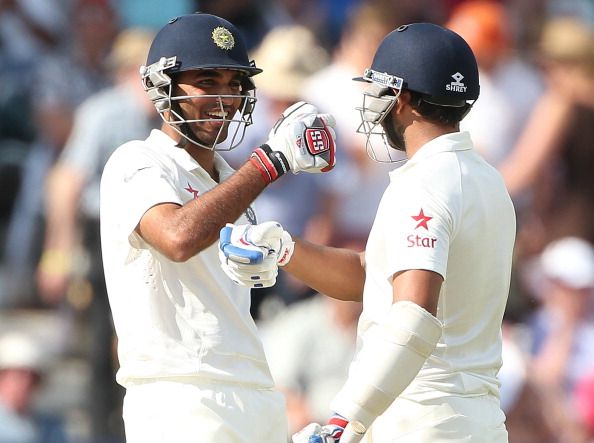
England v India - 2nd Test, Day 2: Bhuvneshwar Kumar covers up for no-show of other Indian bowlers
London, July 19 (IANS/RAY): Without delivering a "coup de grace", the Indian bowlers did reasonably well to contain England on the second day of the second cricket Test when the dice was undoubtedly loaded in favour of batsmen, with the Zimbabwean-born English first drop Gary Ballance cashing in on the opportunity with a patient hundred.
England, predictably, had their noses slightly ahead of India. But they have to bat last on a track that may conspire with spin and reverse swing, thereby suggesting the contest is far from out of India's grasp.
It is an ancient adage that one cannot judge how good or bad a wicket is until two innings have unfolded. This is slightly questionable if one side bowls in helpful conditions and the other in not so conducive circumstances. In other words, England operated on an opening day green top, while India on a second day surce that had become distinctly browner.
Yet the best of the bowlers on either side in the first two days of this match was Bhuvneshwar Kumar. English batsmen are nurtured on negotiating aerial movement. Nonetheless, the 24-year-old Uttar Pradesh "swingwallah" who bends the ball both ways proved a handful. With a disciplined line and length, he not only captured wickets but kept a tight leash on the runs. It was a lesson for the vastly more experienced home bowlers on how not to waste the shine on the ball.
In general, the Indian quicker bowlers made the English batsmen play twice the number of deliveries in the morning session of the second day compared to their counterparts' performance in the same two hours on the first. It is not only a tribute to Duncan Fletcher that he's instilled in his wards not to bowl short or wide but also a compliment to the bowlers to execute the instruction.
With Mohammed Shami noticeably unable to crank up his old velocity, the Indian attack lacks genuine pace: a matter Varun Aaron can rectify, if given an opportunity. The English batsmen were acutely discomfited in Australia by Mitchell Johnson's torridity trained at the ribs. The same tactics could pay dividends if Aaron is drafted in for the third Test in Hampshire, which could offer a harder pitch.
It was, however, refreshing to observe Stuart Binny bowl as fast as, if not faster than Ishant Sharma, who was steady rather than incisive, for he characteristically didn't swing or seam the ball much. Indeed, but for Mahendra Dhoni remaining motionless where he ought to have at least attempted to pouch an outside edge, Binny would have had Ballance caught behind.
Pressure fetches wickets, and Ravindra Jadeja was the beneficiary. Joe Root, the centurion in the first Test, has a reputation of being uncertain at the start of an innings, and he was trapped on the backfoot by the left-armer's stock: an angled in straighter delivery.
The Saurashtrian all-rounder's action is un-classical, for it is open-chested and he doesn't run in diagonally as orthodox left-arm spinners like Bishan Bedi and Dilip Doshi used to. Fletcher has tried to alter this, but the bowler is unable to affect an adjustment. His technical incorrectness, though, may not prevent him from turning the ball on a worn out surface in the fourth innings of this match.
Notwithstanding Ajinkya Rahane's masterclass in technique (the influence of his guru Rahul Dravid clearly evident in this respect) and temperament and on how to pace an innings, this lone hand, bar the pluckiness of Bhuvneshwar, was insufficient to boost India to a par total of 350.
However, baked by an unusually hot sun, the wicket is flattening fast, which could bring reverse swing and spin into the picture earlier than expected. The former would mean Shami might be more effective than he has been.
Tactically, Jadeja should shoulder the bulk of the bowling. This will not only facilitate rotation, and much needed rest, for the faster bowlers in the energy-sapping weather but also avert Dhoni falling foul of the required over-rate.